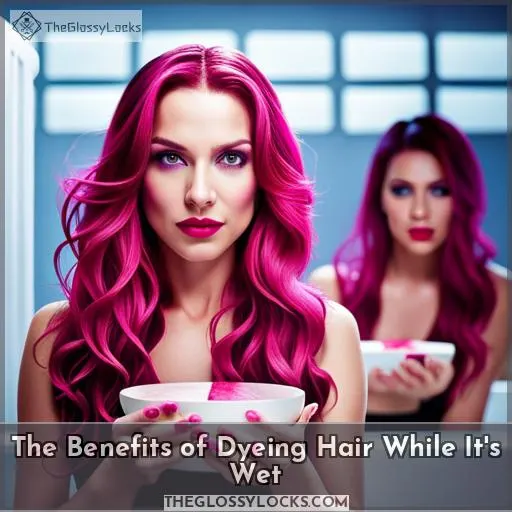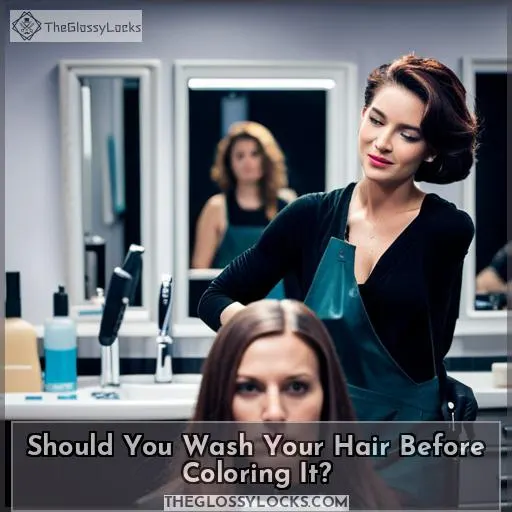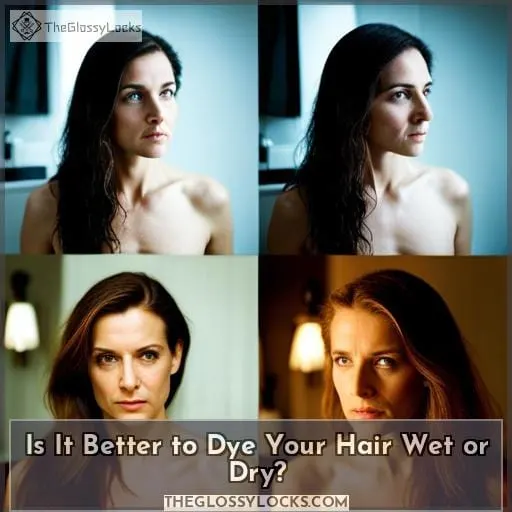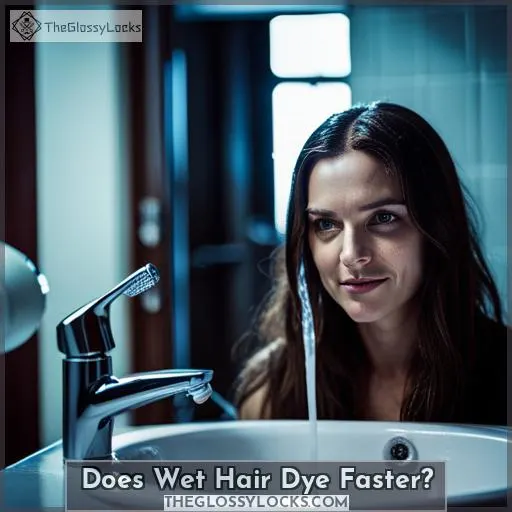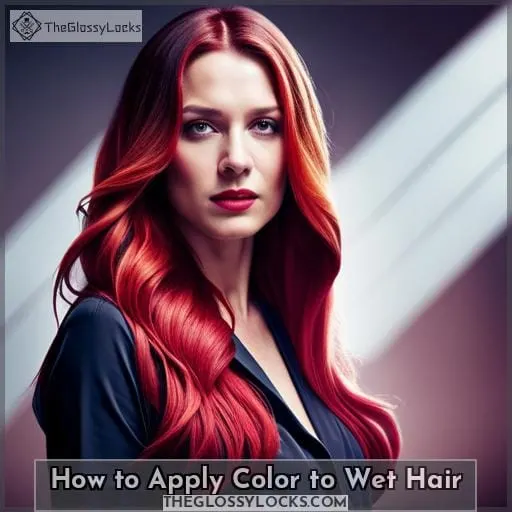This site is supported by our readers. We may earn a commission, at no cost to you, if you purchase through links.
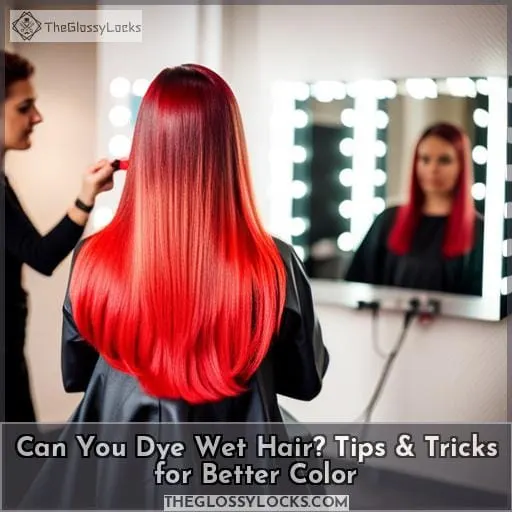
But there are some caveats to consider when coloring damp locks. From what type of color works best on wet hair to which products will give you optimal results.
Table Of Contents
- Key Takeaways
- The Benefits of Dyeing Hair While It’s Wet
- Should You Wash Your Hair Before Coloring It?
- Is It Better to Dye Your Hair Wet or Dry?
- Does Wet Hair Dye Faster?
- What Type of Hair Color Works Best on Wet Hair?
- How to Apply Color to Wet Hair
- What Products to Use to Dye Wet Hair
- Frequently Asked Questions (FAQs)
- Conclusion
Key Takeaways
- Wet dyeing provides subtle, even color using less dye; it works for coarse, thick hair.
- Demi-permanent and semi-permanent dyes are recommended over permanent dyes.
- Dampness allows for even distribution of color and vibrant results from semi-permanent dyes.
- It is important to avoid permanent dyes, use caution with heat tools, and understand hair’s pH levels for optimal wet dyeing results.
The Benefits of Dyeing Hair While It’s Wet
You may be considering dyeing your hair while it is wet, and the benefits of doing so are numerous. Wet dyeing can provide a more subtle result than regular coloring, better color distribution for unevenly textured locks, and less dye needed overall.
Additionally, choosing to wet balayage with a professional will allow for subtle dimension in coarser or thicker hair types.
More Subtle Result
When you dye your hair while it’s damp, the results tend to be more subtle and even-looking. Less dye is needed for this method; wet balayage provides a subtle dimension. It also works better on coarse textures, distributing color evenly.
Semi-permanent or demi-permanent dyes are the best choices; avoid permanent color as it can damage vulnerable wet locks.
Better Color Distribution
Dyeing damp hair gives you a more even color distribution, allowing the dye to be spread evenly throughout your tresses. When preparing your hair for coloring, use a clarifying shampoo to remove buildup as part of your colored hair advice. Choose wisely when selecting a dye; demi-permanent or semi-permanent options are best for wet hair.
Pay attention to the pH balance and texture of your strands before applying any product.
Wet drying opens up cuticles, making them more receptive to dyes and toners.
Maintaining an acidic environment is key in achieving optimal results with less damage.
Color molecules can penetrate better into each strand if the solution has been balanced correctly in terms of pH levels – providing an even color coverage without over saturating the locks! Letting water do its job will help you get that desired outcome faster than using other methods while preserving the luster and shine of your mane!
Less Dye Needed
Less dye is needed when you color your hair while wet, so you can save some money in the long run. Dyeing safety and pH balance are important – choose a demi- or semi-permanent shade for damp application.
Wet dyeing opens cuticles to allow even distribution of color shades, creating vibrant gray coverage with less product used overall.
Subtle Dimension
You can achieve subtle dimension when dyeing your hair while wet, giving you a natural-looking color and texture. Moisture balance and pH levels help maintain toner coverage, enhancing saturation of the color change.
Bright accents are achieved by opening the cuticle with semi-permanent dyes or conditioners for maximum effect.
Suitable for Coarse or Thick Hair Texture
Coarse or thick hair textures benefit from the subtle dimension of dyeing while wet. Permanent and hi-lift tint colors should be avoided as they are too harsh for vulnerable, dampened hair. Demi-permanent and semi-permanent dyes work best in this situation since they don’t permeate the cuticle, yet still provide vibrant results when paired with conditioners, bright colors, and toners that are acidic or alkaline depending on their pH level to regulate water-based solutions.
Water pulls color in rather than diluting it if towel-dried properly, so less dye is needed during processing time, thus opening up a world of possibilities without sacrificing quality coverage.
Should You Wash Your Hair Before Coloring It?
It’s best to use caution when deciding whether or not you should wash your hair before coloring it. After all, dyeing your hair can be a tricky task that requires knowledge and understanding beforehand.
Before coloring, review the basics of dyeing hair and decide on what color option is best for you.
To protect your locks from damage while using an at-home color kit, it’s important to understand how pH works in relation to developer use as well as shampoo rinses. As mentioned previously, wetting hair with water instead of washing it with shampoo will open up its cuticles so that less product is required overall.
However, this may also cause faster application times if done incorrectly without paying attention to timing instructions given by a professional stylist or included within box dyes themselves.
If applying permanent colors at home, always make sure the pH balance does not exceed 7 since higher alkalinity levels could lead to unwanted results such as brittle strands or breakage over time due to excessive exposure to chemical components found in most products used for dyeing purposes.
Make sure other ingredients are correctly balanced out during each step of the application process, including pre-treatment shampoos, rinses, toners, etc.
Understanding the general principles behind coloring techniques helps prevent unnecessary risks taken on one’s own head full of beautiful locks! Always consult professionals when unsure about anything related to proper usage of specific products and the desired end result expected from them.
Read labels carefully and never forget the importance of testing the pH scale and doing strand tests prior to actual treatment procedures performed either by yourself or someone else.
Is It Better to Dye Your Hair Wet or Dry?
Whether you choose to color your locks damp or dry, it’s important to understand the pros and cons of each option.
Wet dyeing can help protect hair from damage while also providing a subtle result that evens out the overall tone. It requires less dye than dry coloring and works best for coarse, thick hair as it helps distribute the color more evenly within strands.
For semi-permanent dyes, wetting provides a vibrant result since cuticles are opened up when dampened with water. Demi-permanent and semi-permanent dyes work best on wet hair as they do not permeate into the cuticle like permanent colors would – which could be too harsh if applied directly after washing.
However, before attempting any coloring yourself at home, make sure you understand pH balance.
Always wear gloves before applying any sort of product to avoid staining skin, in addition to using some type of mask protection during processing time!
As far as which method is better? Ultimately, that decision depends on what look you’re going for: bright pastel colors or toners often lend themselves better towards wet locks, but deeper hues may require drying beforehand in order to get an accurate outcome without oversaturating sections or missing spots altogether!
Does Wet Hair Dye Faster?
Continuing on the question, is it better to dye your hair wet or dry? We now arrive at a related inquiry: does wet hair dye faster? The answer is yes and no.
Yes, because if you’re going for subtlety, then applying color to damp locks can help create an even look while using less product than when dealing with dry strands. But also no – as proper care must be taken before and after coloring to ensure that any heat damage from hot tools (such as blow-drying) isn’t too extreme for healthy tresses.
When crystalizing lightening techniques are utilized on already-wet manes, there’s a higher risk of further damaging the cuticle layer due to its open state. So understanding which types of dyes work best under such conditions (demi/semi-permanent over permanent), along with selecting products without ammonia or hydrogen peroxide, will prevent additional harm done by strong chemicals in harsher formulas.
Additionally, being familiar with pH levels and how they affect both hair structure and cortex during the process should never be overlooked either. Maintaining acidic solutions around 7 closes up each strand’s cuticle, whereas alkaline ones above swell them instead – allowing colors deeper penetration into every follicle accordingly depending upon desired results achieved through careful color correction protocol employed correctly.
In short, when asking Can you dye wet hair? know that not only is it possible but can provide some great benefits too! However, safety precautions like avoiding heat styling afterwards must always take precedence over achieving fast results since preserving overall texture trumps all else.
What Type of Hair Color Works Best on Wet Hair?
You may be wondering which type of hair color works best on wet hair. Dyeing wet hair is possible, but it can damage the strands if not done properly. The safest and most successful dyes for this process are demi-permanent dye, semi-permanent dye, and other temporary colors – all of which provide subtle results while helping to protect your tresses from further harm.
Demi-Permanent Dye
Demi-permanent dye is best for wet hair, as it won’t permeate the cuticle and helps create subtle results. Understand pH balance to get optimal color timing and achieve the best results. Towel drying properly preserves hair structure while preventing water from diluting the dye.
Wear gloves when applying demi-permanent dyes to avoid staining your hands or clothes.
Semi-Permanent Dye
Semi-permanent dye provides vibrant color and dimension to your locks, without altering the structure of your hair. It is a great choice for wet coloring as it doesn’t permeate the cuticle like permanent dyes.
Here’s what you should know when working with semi-permanent:
- Color mixing: use multiple shades for a custom look.
- pH balancing: keep in mind that developer and other products are acidic or alkaline.
- Product selection: choose heat protection to avoid damage while drying.
- Heat protection: use care when applying heat near wet hair.
- Towel drying: gently pat dry rather than rubbing vigorously.
The right product selection, thoughtful color mixing, and pH balance, along with careful towel drying, will help ensure safe coloring on dampened tresses!
Other Temporary Dyes
Try out temporary colors and toners to give your locks a vibrant, dynamic look. Pastel colors can be safely used on wet hair since they are not as strong as permanent dyes. A good rule of thumb is to use acidic products (pH lower than 7) for semi-permanent dyeing.
Alkaline products (pH higher than 7) should only be used when necessary due to their strength affecting the structure of hair. Developer, shampoo, and conditioner are all acidic, while demi-permanent color tints and lightener require alkaline pH levels to open up the cuticle layer, making them ideal for dampening prior application.
With these tips, you’re sure to get amazing results without compromising your hair’s health!
How to Apply Color to Wet Hair
Applying color to wet hair is an art form that requires the right products, a thorough understanding of pH, and careful timing – all of which you can master with practice.
Before beginning any coloring process on wet hair, there are some steps to consider:
- Pre-color prep: Make sure your scalp is clean and free from oils or styling products prior to applying dye.
- Developer levels: Use a lower strength developer than usual when working with wet hair, as it will absorb more quickly into the cuticle layer and avoid over processing due to prolonged exposure time in a watery environment.
- Toner choices: Select a toner for use on dampened strands that specifically states it’s safe for use on moistened locks if looking for a lightening option after prepping.
- Hair texture: The type of product used should also reflect your individual strand consistency – coarser textures may require higher strength formulas while finer ones need gentler treatment options.
- Scalp pH balance: Understand what level works best without causing further irritation or damage by researching online resources or consulting professionals regarding proper acidity/alkalinity balances before commencing the task at hand.
With these tips in mind, you’re now ready to start experimenting with colors ranging from vibrant hues, balayage effects, ombres, pastels, etc. on newly washed locks! No matter what look you desire, one thing remains certain; take extra precautions when dealing with post-dyeing processes such as heat tools (blow dryers), brushing techniques, etc.
What Products to Use to Dye Wet Hair
It’s time to take a look at the products you should use when dyeing wet hair.
First, let’s review the basics of the pH scale and how it affects your hair structure.
The magic of damp hair is that it opens up cuticles and helps distribute color more evenly – allowing better gray coverage with less product used in the process.
When selecting which type of dye to use for wet coloring, remember that demi-permanent or semi-permanent dyes are recommended over permanent ones since they will be gentler on vulnerable strands.
Keep in mind too that temporary bright colors and toners can be safely applied while wet as well!
The First Step
Starting off right is the key to a successful hair dye job – so be sure to give your locks some TLC before you break out the coloring kit! Neutralizing pH and product selection are essential for wet hair dyeing.
Developer choice depends on tone selection, while pre-dye prep calls for minimal water usage. Hair should be damp, not soaked, with correctly chosen products that will leave it looking healthy post-dye.
PH Scale Simplified
Knowing the pH scale is essential when dyeing your hair, as it helps to determine which products will provide the best results. The pH balance regulates acidity levels, with acidic solutions having a value below 7 and alkaline solutions above.
Acidic solutions smooth hair, while alkaline solutions swell it. Both affect color absorption in different ways.
When applied on wet strands, the cuticle layers open up, allowing dyes to penetrate deeper into the hair structure for better coverage or vibrancy of semi-permanent colors.
Knowing how this works can help you get great results with each dye job!
The Magic of Damp Hair
Discover the magic of damp hair when coloring – it helps distribute color and make semi-permanent dye more vibrant! Understand that wet dyeing works best with careful selection of color and chemical balance, so use a toner to ensure even results.
Hair structure is key for successful wet coloring; pH determines if your products open or close cuticles. With professional help, you can achieve subtle balayage looks or bolder colors without overloading on chemicals.
Things to Keep in Mind
When it comes to dyeing wet hair, there are a few things you should keep in mind to ensure successful coloring. Ensure proper moisture balance, understand hair structure and pH levels, and select the right type of dye for application.
To maintain healthy locks while dyeing wet strands, consider using demi or semi-permanent color that won’t permeate cuticles or damage delicate strands.
Frequently Asked Questions (FAQs)
Can I dye my hair while it’s still wet from the shower?
You can dye your wet hair, but proceed with caution. It’s best done by professionals as it can damage the hair if not done correctly.
Is it safe to dye wet hair at home?
Dyeing wet hair at home can be risky as it is more vulnerable to damage. However, demi-permanent and semi-permanent dyes are best for this purpose since they don’t penetrate the cuticle like permanent dye does.
Does dyeing wet hair cause more damage to the hair than dyeing dry hair?
Yes, because wet hair is more vulnerable and requires harsher chemicals. Dyeing it this way increases the risk of damage to the cuticle and shaft, making fading difficult. Use demi- or semi-permanent dyes for best results; avoid permanent dye altogether.
How long should I wait to wash my hair after dyeing it while wet?
After dyeing, following the right washing frequency and timing, wait 48 hours after dyeing your wet hair before washing it. This ensures that the color has fully set and you can enjoy vibrant, even results without risking damage to your locks!
Is there a risk of the dye running or fading if I dye my hair while wet?
Yes, there is a risk of the dye running or fading when coloring wet hair. Choose semi-permanent or demi-permanent dyes to ensure the color stays vibrant and even.
Conclusion
Like a painter with a brush, you can use hair dye to add a splash of color to your life. Dyeing wet hair can give you a more subtle result, better color distribution, and require less dye. It can also provide a subtle dimension and is suitable for coarse or thick hair texture.
Wet hair dye can be faster, but it’s best to follow the instructions of the dye you’re using. Demi-permanent and semi-permanent dyes work best on wet hair, as well as other temporary dyes. To ensure the best results, make sure to use the right products and understand the pH scale.
With the right knowledge and care, you can dye your hair while wet and achieve beautiful results.

